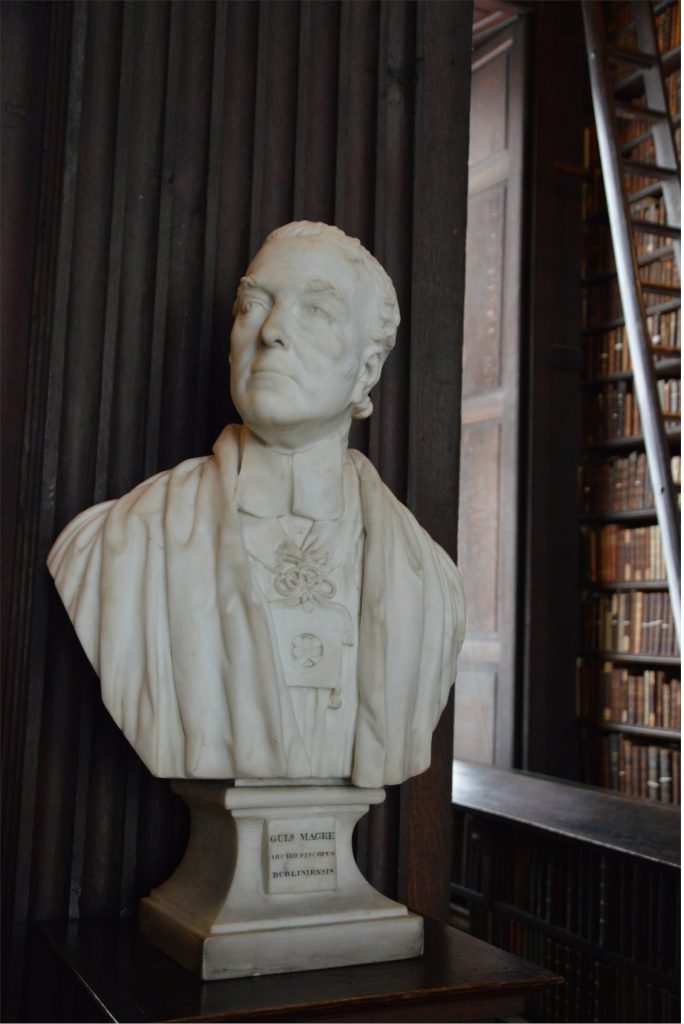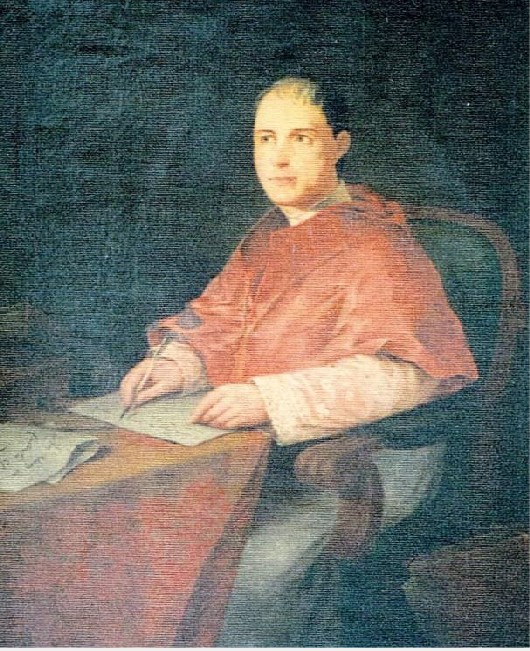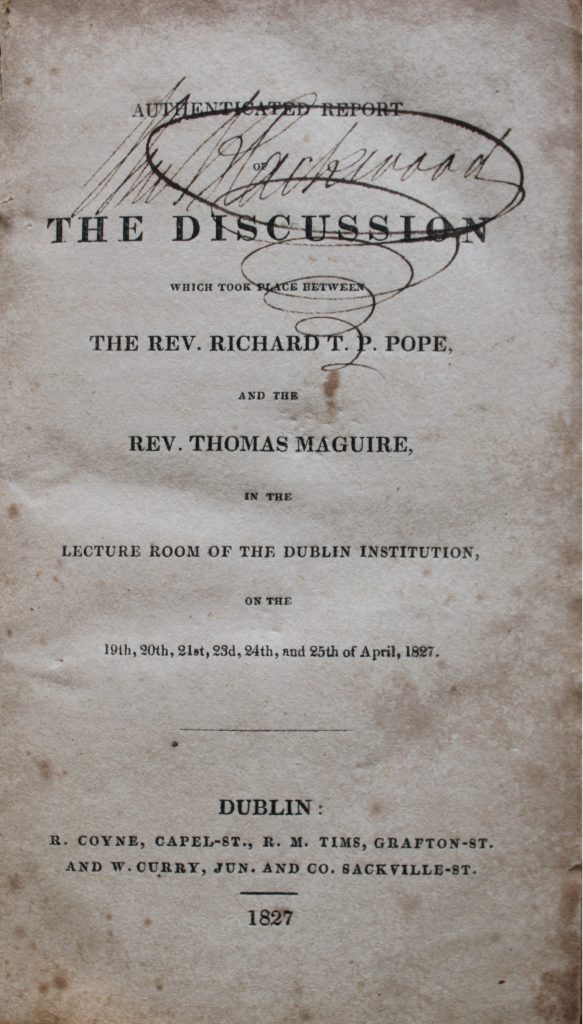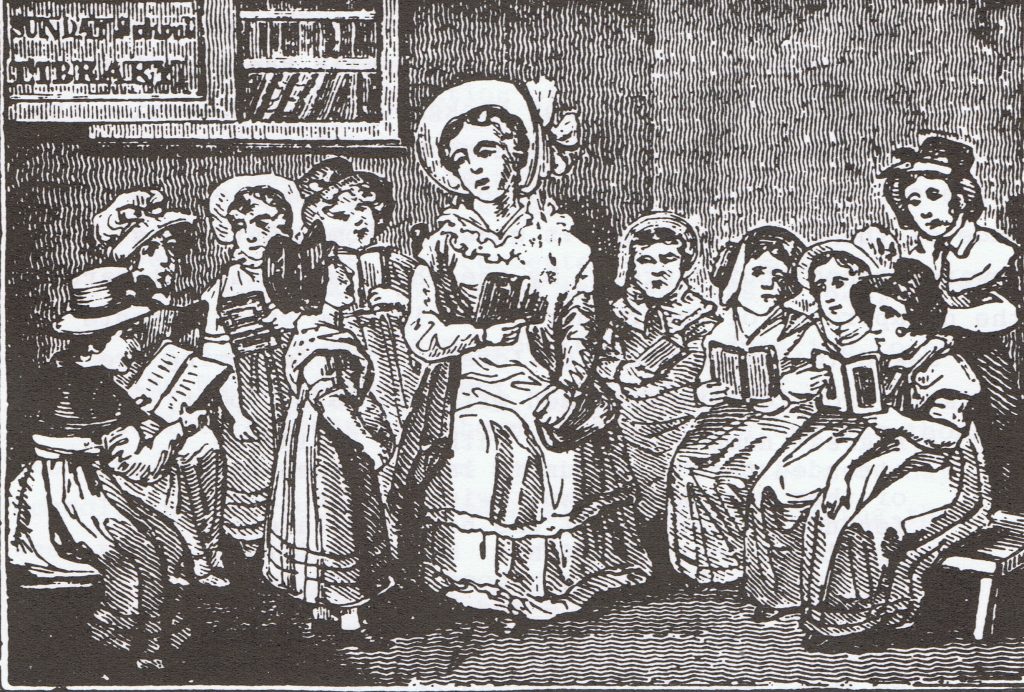McClay exhibition explores Second Reformation in pre-Famine Ireland
Guest post by Dr Ciarán McCabe (School of HAPP, Queen’s University Belfast).
A new exhibition focusing on one of the most disruptive periods in nineteenth-century Ireland is currently running in the McClay Library. ‘The Second Reformation and Catholic–Protestant Relations in Pre-Famine Ireland: Bicentennial Perspectives’ brings together unique holdings in the McClay Library to explore a period from the 1820s to 1840s when sectarian hatred, suspicion and rivalries dominated the public sphere, on both national and local levels. The exhibition, jointly curated by the present author, Alexandra Caccamo (Maynooth University Library) and Special Collections staff from the McClay Library, comprises materials from the university’s library holdings pertaining to the ‘Second Reformation’, which was a sustained and renewed effort by Protestant missionaries — mostly members of the Church of Ireland, but also including Presbyterians and Methodists — to turn Irish Catholics away from “Romish errors and superstitions” and towards “true religion”. Exhibition panels inform the visitor of the background to the Second Reformation; the emergence of the Bible War of the mid-1820s; the significance of a vibrant print culture in fomenting discord and religious controversy; the role of landlords in promoting evangelical missions on their estates; and a case study of a bitter schism in Birr, County Offaly, where two Catholic priests and hundreds of their congregants converted to Presbyterianism. The exhibition’s display cases contain materials from the McClay Library’s extensive collections, and represent the arguments and viewpoints of both sides in this prolonged period of acute interdenominational discord.

The exhibition’s first run was in the Russell Library, Maynooth University, where it was launched on 24 October 2022, 200 years to the day after the newly-installed Church of Ireland archbishop of Dublin William Magee (1766–1831) delivered in St Patrick’s Cathedral, Dublin his infamously febrile sermon, or charge, to his clergy, calling for a greater and more zealous endeavour to evangelise among the Irish Catholics: this charge was widely seen as playing an influential role in driving the Second Reformation. While Protestant evangelicals and missionaries had been active throughout Ireland since the late eighteenth century, Magee’s sermon was significant in returning acute religious controversy to the Irish public sphere. Notoriously, the prelate’s charge generated criticism from both Catholics and Presbyterians, for its dismissive treatment of their respective churches and its promotion of the Church of Ireland as the sole legitimate ecclesiastical entity in Ireland. The main opponents to the Established Church’s endeavours in advancing this privileged role were, Magee asserted, Catholicism and Presbyterianism, “the one possessing a Church without what we can call a Religion and the other possessing a Religion without what we can call a Church”. To counter these malign forces in Irish society, Magee called on his fellow Anglicans to effect a renewed campaign of reformation: “From this spirit of tempered freedom and qualified submission sprung the glorious work of the Reformation, by which the Church of these countries, having thrown off the slough of slavish superstition, burst into the purified form of Christian renovation.”

Among the direct results of Magee’s charge was the emergence of the Catholic bishop of Kildare and Leighlin James Doyle (1786–1834) as a leading voice of growing Catholic confidence and assertion in the public sphere. Doyle’s criticisms of Magee’s sermon addressed not solely theological but also legal and constitutional grievances, identifying, for instance, tithes as evidence of the supposed illegitimacy of the Established Church’s privileged position. It is significant that just seven months after Magee’s charge, during which time Doyle led the Catholic counter-attack on Protestant aspersions of the Roman church, Daniel O’Connell (1775–1847) and Richard Lalor Sheil (1791–1851) founded the Catholic Association, to campaign for Catholic Emancipation.

The Second Reformation was not only played out in printed culture, through an intemperate pamphlet literature: rather, a series of incidents in the mid-1820s, whereby Catholic crowds interrupted meetings of Protestant bible societies, led to the holding of organised theological debates (or controversies). The most famous of these was the six-day debate between Catholic priest Rev. Thomas Maguire (1792–1847) and Church of Ireland minister Rev. Richard T. P. Pope (1799–1859) in Dublin. The well-advertised, ticketed debates were attended by large crowds, with the proceedings being printed in the weeks after the debate’s conclusion. The Second Reformation also appealed to a number of Irish landlords, with evangelical missions being established on the Powerscourt estate in Wicklow, the Roden estate in north Leinster and the Farnham estate in south Ulster.

The exhibition runs at the McClay Library, QUB until late August 2023 and is funded by Offaly County Council’s Heritage Office, through its Creative Ireland funding stream, Maynooth University Library, St Patrick’s College Maynooth, the National Bible Society of Ireland and the Catholic Historical Society of Ireland.
There is an accompanying online exhibition.
If you are interested in attending the exhibition or require further information, please contact the library on 028 9097 6333 or specialcollections@qub.ac.uk
Bibliography
Bowen, Desmond, The Protestant crusade in Ireland, 1800–70: a study of Protestant-Catholic relations between the Act of Union and Disestablishment. Dublin: Gill and Macmillan, 1978
Brown, Stewart J., The national churches of England, Ireland, and Scotland, 1801–1846.
Oxford: Oxford University Press, 2001.
Whelan, Irene, The Bible War in Ireland: the ‘Second Reformation’ and the polarization of Protestant-Catholic relations, 1800–1840. Dublin: Lilliput Press, 2005.
Gribben, Crawford and Andrew R. Holmes (eds), Protestant millennialism, evangelicalism, and Irish society, 1790–2005. Basingstoke: Palgrave Macmillan, 2006.
McGrath,mThomas (ed.), The pastoral and education letters of Bishop James Doyle of Kildare and Leighlin, 1786–1834. Dublin: Four Courts, 2003.
Moffitt, Miriam, The Society for Irish Church Missions to the Roman Catholics, 1849–1950. Manchester: Manchester University Press, 2010.
Hempton, David and Myrtle Hill, Evangelical Protestantism in Ulster society, 1740–1890. London, Routledge, 1992.

